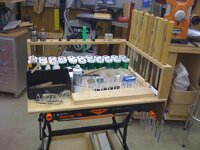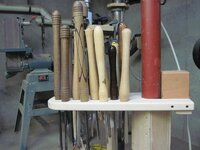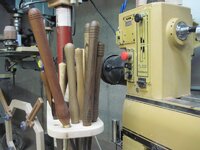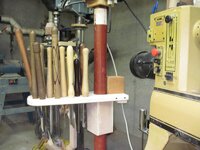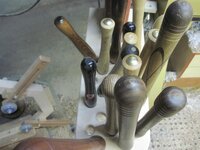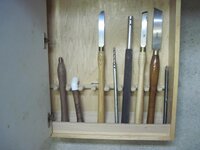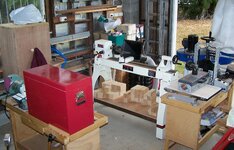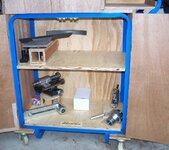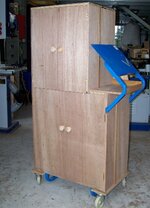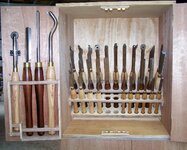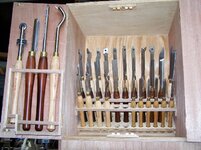After all these many years I still use my friendly five gallon plastic bucket for my lathe cutting tools. Everything else is all over the place ...
I cut a circle of 3/4" MDF and sized it to fit in the taper of the bucket, but down about 3" inside. Then drilled eight equally spaced holes to accept 2" PVC tubes cut to be just above the MDF ring by an inch or so. This length holds the sharp cutting edge up on the foam and off the very bottom of the bucket.
I filled the bottom of the bucket with about four inches of Plaster-of-Paris, put the PVC tubes in a roughly shaped circle, set the MDF top over the tubes adjusting each one as necessary and leveled the MDF in relation to the top of the bucket. I previously covered the bottom of each tube with plastic wrap and taped them securely onto the ends. This helped prevent any of the Plaster-of-Paris from getting inside. Simply bumping the bucket a couple of times and the Plaster-of-Paris was settled around each tube. Minor adjusting put them in as verticle a ring as was visably possible.
Set the contraption aside overnight so the Plaster-of-paris could properly set-up. In the morning I cut eight pieces of 2" foam to plug the bottoms of the PVC tubes and protect the cutting edges of my tools. I also put just a quick spurt of WD-40 on these for rust control. Pushed these foam pieces to the bottom of the PVC, set the tools in each tube with the cutting ends down to protect the sharp edge from being damaged, and placed the entire thing at a comfortable spot at the lathe. The Plaster-of-Paris makes the bucket "tip over proof" which is a hidden benefit.
If and when I need to move the bucket I just pick the entire thing up by the bucket handle and reposition it.
I also have a small tin can with a cover for the small replacement heads for various tools. This sits very nicely in the center of the circle of PVC tubes and is very convenient. WD-40 is also sprayed inside it for rust control of the parts. The WD-40 seems to keep the flat pieces from sliding all over and maybe this helps prevent the sharp edges from damage as well.
All in all it took about two hours to cut and drill everything to size, mix and pour the Plaster-of-Paris, and set the tubes in place (by far the hardest part of assembly.) Still had to wait overnight to let stuff set up ... but worth every penny to make which was $0.00 as I used items/pieces parts already in the shop.
If I ever go to visit someone in their shop I just grab my (now heavy) bucket with all the tools and off I go. BTW, I had all my tool handles laser engraved with my name for ID purposes long time ago. AND, If there is an empty PVC tube ... something is missing and/or is about to be left behind.


![toolcart2 [800x600].JPG](/data/attachments/35/35080-b8cbb90d6733a0cac703c1b638379f07.jpg?hash=uMu5DWczoM)
![toolcart3 [800x600].JPG](/data/attachments/35/35081-60f52298bba79aef2bb25677b23256e0.jpg?hash=YPUimLunmu)
